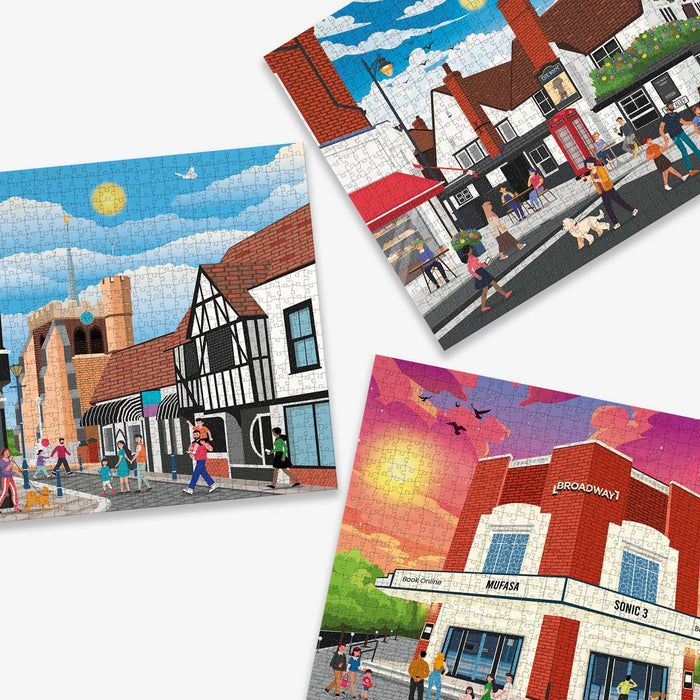Introduction
Jigsaw puzzles, they're a classic pastime enjoyed by people of all ages around the world. From rainy afternoons spent piecing together landscapes to family gatherings centered around a challenging puzzle, the appeal of jigsaws is undeniable. But have you ever wondered about the origins of this beloved activity? or the benefits of jigsaw puzzles? Join us on a journey through time as we explore the fascinating history of jigsaw puzzles, from their ancient roots to their modern-day popularity.
Ancient Origins: The Birth of Puzzle Pieces
As long as humans have sought entertainment and mental stimulation, puzzles have been a part of our cultural landscape. Early precursors to modern jigsaw puzzles can be found in ancient civilisations, where puzzles served as both recreational activities and educational tools. One of the earliest examples of a puzzle-like game is the Tangram, an ancient Chinese puzzle consisting of seven flat pieces called tans, which are rearranged to form various shapes and designs. Dating back to the Song Dynasty (960–1279 AD), the Tangram remains popular to this day for its simplicity and endless creative possibilities.
In Europe, early puzzles emerged in the form of dissected maps and educational aids. These puzzles, typically made of wood, were used to teach geography, history, and other subjects to children of wealthy families during the 18th and 19th centuries. Pieces were hand-cut and often accompanied by a guide or key to help assemble the puzzle correctly.

Asia in its Principal Divisions, by John Spilsbury, 1767 puzzle © British Library Board/Bridgeman Images.
The Birth of the Modern Jigsaw Puzzle
The modern jigsaw puzzle as we know it owes its existence to John Spilsbury, an English cartographer and engraver who is credited with inventing the first jigsaw puzzle in the 1760s. Spilsbury created a wooden puzzle by mounting a map onto a sheet of hardwood and cutting it into pieces along the borders of the countries. The resulting puzzle pieces, when assembled, formed the original map. Spilsbury's creation was intended as an educational tool for teaching geography, but it quickly gained popularity as a recreational activity among the upper class and a key event in the history of jigsaw puzzles.
In the early 20th century, jigsaw puzzles underwent a significant transformation with the introduction of cardboard puzzles. Advances in printing technology allowed manufacturers to produce puzzles with vibrant images on durable cardboard, making them more affordable and accessible to the masses. Cardboard puzzles quickly became a popular form of entertainment for people of all ages, from children to adults.
The Golden Age of Jigsaw Puzzles
The 20th century saw a boom in the popularity of jigsaw puzzles, cementing their status as a beloved pastime. During the Great Depression, puzzles offered affordable entertainment for families struggling through economic hardship. Priced at just a few cents, puzzles provided hours of diversion and escape from the challenges of daily life. Manufacturers capitalized on this demand by producing a wide range of puzzle themes, from picturesque landscapes to scenes from popular culture.
Jigsaw puzzles for adults also played a significant role during wartime, providing solace and distraction to soldiers on the front lines and civilians on the home front alike. Puzzles featuring patriotic images and scenes of national pride served as reminders of unity and resilience during times of adversity. Additionally, puzzles were used therapeutically to aid in the rehabilitation of injured soldiers, providing mental stimulation and a sense of accomplishment.
Evolution and Innovation
Technological advancements: From hand-cut wooden pieces to precision manufacturing
As jigsaw puzzles gained popularity throughout the 20th century, advancements in technology revolutionised the manufacturing process. What once involved hand-cutting wooden pieces became streamlined through precision manufacturing techniques. Automated cutting machines replaced the labor-intensive process of hand-cutting, allowing for faster production and greater consistency in piece shapes and sizes.
With the advent of computer-aided design (CAD) and laser cutting technology, puzzle manufacturers are now able to create puzzles with intricate designs and complex shapes. This level of precision has elevated the artistry of jigsaw puzzles, allowing for more detailed images and challenging puzzles.

Puzzle themes and variations: From landscapes to pop culture
One of the enduring appeals of jigsaw puzzles is the wide range of themes and variations available to puzzle enthusiasts. From serene landscapes and picturesque scenes to iconic landmarks and works of art, there's a puzzle to suit every taste and interest.
In addition to traditional themes, puzzle manufacturers have embraced popular culture, creating puzzles featuring beloved characters from movies, television shows, and video games. Whether you're a fan of Star Wars, Harry Potter, or Marvel superheroes, there's a puzzle out there waiting to be assembled.
3D puzzles and beyond: Pushing the boundaries of traditional puzzling
In recent years, the world of jigsaw puzzles has expanded beyond the traditional flat puzzle format to include three-dimensional puzzles and other innovative designs. 3D puzzles challenge puzzlers to think spatially and creatively as they assemble intricate structures, such as buildings, landmarks, and even famous works of architecture.
Advancements in puzzle engineering have also led to the development of puzzles with unconventional shapes and designs, such as circular puzzles, double-sided puzzles, and puzzles with irregular edge pieces. These unique puzzles offer an added layer of challenge and excitement for puzzle enthusiasts looking to push the boundaries of traditional puzzling.
The Enduring Appeal of Jigsaw Puzzles
The therapeutic benefits of puzzling: Stress relief and mindfulness
Beyond their entertainment value, jigsaw puzzles offer a host of therapeutic benefits for both the mind and body. Engaging in puzzling can provide stress relief, promote mindfulness, and improve cognitive function. The repetitive nature of assembling puzzle pieces can have a calming effect on the brain, helping to reduce anxiety and promote relaxation.

Social aspects: Bringing families and communities together
Jigsaw puzzles have a remarkable ability to bring people together, whether it's families gathering around the dining table on a rainy day or communities coming together for a puzzle night event. Puzzling encourages collaboration, communication, and teamwork as individuals work together to solve the puzzle and achieve a common goal.
The rise of online puzzling: Connecting puzzle enthusiasts worldwide
In recent years, the rise of online puzzling has transformed the way people engage with jigsaw puzzles. Websites and mobile apps offer a vast selection of virtual puzzles to solve, ranging from classic landscapes to custom designs created by users. Online puzzling allows enthusiasts to connect with fellow puzzlers from around the world, share tips and strategies, and participate in virtual puzzle competitions and events.
Jigsaw Puzzles in Pop Culture
Puzzles in literature and film: Representations in popular media
Jigsaw puzzles have made appearances in literature, film, and television, often serving as symbols of mystery, discovery, and intellectual challenge. From Agatha Christie's detective novels to iconic movie scenes featuring characters solving puzzles, jigsaw puzzles have left an indelible mark on popular culture.
The jigsaw puzzle as a metaphor: Symbolism in art and literature
In addition to their portrayal in popular media, jigsaw puzzles have been used as metaphors in art and literature to represent themes of unity, complexity, and the search for meaning. Artists and writers have employed the image of the puzzle to explore concepts of identity, relationships, and the interconnectedness of human experience.
Celebrities and their love for puzzling: From Queen Elizabeth II to Bill Gates
Surprisingly, jigsaw puzzling has attracted a diverse array of celebrity enthusiasts, from royalty to tech moguls. Queen Elizabeth II of England is known to enjoy puzzling as a leisure activity, while Microsoft co-founder Bill Gates has revealed his passion for puzzles in interviews and social media posts. Their affinity for puzzling serves as a testament to the universal appeal of this timeless pastime.
The Future of Jigsaw Puzzles
Technological advancements: Virtual reality and augmented reality puzzles
As technology continues to evolve, the future of jigsaw puzzles holds endless possibilities. Virtual reality (VR) and augmented reality (AR) technology offer new ways to experience puzzling, immersing players in virtual environments and providing interactive elements to enhance the puzzle-solving experience. VR and AR puzzles allow for greater customization, interactivity, and immersion, blurring the lines between physical and digital puzzling.
Environmental concerns: Sustainable materials and practices
In response to growing environmental concerns, puzzle manufacturers are exploring sustainable materials and practices to reduce their ecological footprint. From using recycled cardboard and paper to implementing eco-friendly packaging and production methods, the industry is taking steps to minimize waste and promote sustainability.
Puzzling in the digital age: Balancing tradition with innovation
In the digital age, traditional jigsaw puzzles coexist alongside their digital counterparts, offering enthusiasts a choice between physical and virtual puzzling experiences. While digital puzzles offer convenience and accessibility, traditional puzzles have massive educational benefits for children solving jigsaw puzzles as a tactile and sensory experience that cannot be replicated digitally. As technology continues to advance, the challenge lies in striking a balance between tradition and innovation, ensuring that the timeless appeal of jigsaw puzzles endures for generations to come.

Conclusion - The History Of Jigsaw Puzzles
In conclusion, the history of jigsaw puzzles is a rich tapestry of innovation, creativity, and enduring popularity. From their ancient origins to their modern-day evolution, jigsaw puzzles have captivated the hearts and minds of people around the world for centuries. As we look to the future, the world of puzzling holds endless possibilities, promising new challenges, experiences, and adventures for enthusiasts of all ages.
So, whether you're a seasoned puzzler or new to the world of jigsaw puzzles, we encourage you to continue exploring, discovering, and embracing the joy of puzzling. After all, there's nothing quite like the satisfaction of fitting that final piece into place and revealing the complete picture.



